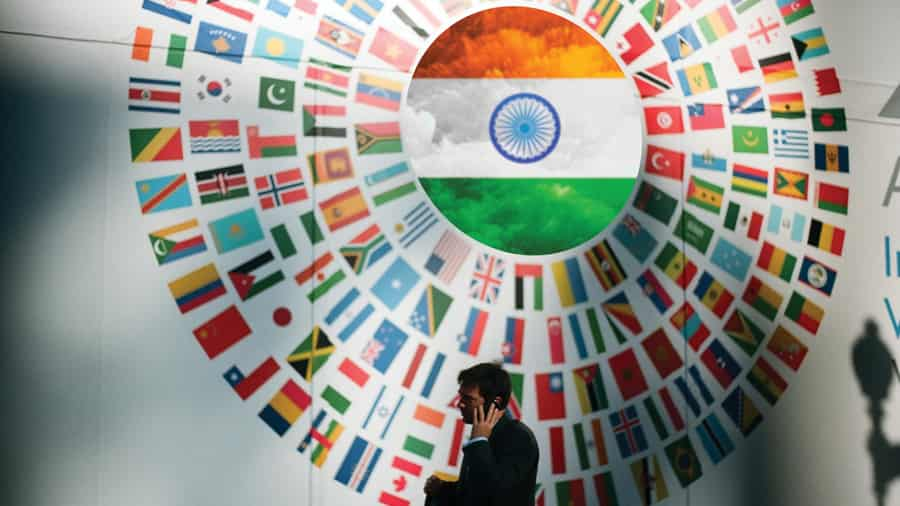In a whirlwind diplomatic tour that spanned Latin America and Africa, Indian Prime Minister Narendra Modi is reshaping global geopolitics — one lithium deal, one uranium mine, and one QR payment at a time. This isn’t just a symbolic outreach. It is a calculated, strategic realignment designed to place India at the center of a newly emerging “Global South corridor.”
From Salt Flats to Nuclear Reactors: A New Resource Map
Modi’s trip began in Argentina’s sun-drenched province of Catamarca, home to the shimmering salt flats of the Salar del Hombre Muerto. Beneath these expanses lies lithium — the critical ingredient for every electric vehicle battery India will need to meet its carbon neutrality pledge by 2070. With a signed agreement in hand, Indian state-owned enterprises now hold exploration rights to two rich blocks in the basin. The phased investment potential? Up to $600 million.
Next stop: Namibia. Beneath the rolling dunes of the Namib desert lies Etango, one of the world’s largest untapped uranium reserves. In a significant move to reduce reliance on Russian and Kazakh uranium, Modi signed a joint development agreement with President Nangolo Mbumba and India’s Nuclear Power Corporation. With 23 nuclear reactors currently online and 10 more in progress, India’s demand for yellowcake is accelerating — and it needs geopolitically neutral suppliers.
Together, these moves mark more than resource grabs. Analysts describe them as the beginnings of a “Southern Resource Corridor”: a supply arc from the Andes to southwestern Africa meant to power India’s green tech boom — and deepen its investment footprint in regions long dominated by China or the West.
More than Minerals: Exporting the India Stack
But minerals alone don’t forge enduring partnerships. India is betting on digital diplomacy too.
In Port of Spain, Trinidad and Tobago, Modi and Prime Minister Keith Rowley announced that the country would be the Caribbean’s first adopter of India’s UPI (Unified Payments Interface) — a real-time digital payments platform. UPI is the first layer of the India Stack, a suite of open-source public digital infrastructure that includes biometric ID, health records, tax platforms, and e-payments.
“UPI transformed how street vendors in India get paid,” Modi said. “We want the same leap for Caribbean entrepreneurs.”
It’s a powerful offer. In March alone, UPI processed over 11.3 billion transactions. Unlike proprietary systems like Alipay or PayPal, UPI is open-source. Partner nations can use the platform without surrendering data sovereignty or paying licensing fees. The servers remain local. The code remains open.
“This isn’t a Trojan horse — it’s a toolbox,” explained Jayanth Krishnamurthy of the Indian Institute of Information Technology.
The Inter-American Development Bank has already funded UPI feasibility studies in Costa Rica and Peru. Imagine QR payments across Latin America running on Indian software, scanned by phones powered with local lithium. That feedback loop — local resources enabling local innovation — may be Modi’s smartest bet yet.
Multilateral Levers, Redefined
On the diplomatic front, Modi’s tour wasn’t about smiles and photo ops. It was about shifting the balance of global power.
In Brasilia, Modi and President Luiz Inácio Lula da Silva revived support for the G4 — a coalition of India, Brazil, Germany, and Japan lobbying for permanent seats on the UN Security Council. “The council reflects 1945, not 2025,” Lula told reporters.
Political analyst Oliver Stuenkel called their joint statement “a new language for a new world,” describing a shift from portraying the Global South as victims to promoting it as a mosaic of mutual interests.
India endorsed Brazil’s COP33 climate summit bid. Brazil, in turn, backed India’s Nuclear Suppliers Group membership. These are not casual favors. As Princeton’s Arjun Bhatia put it, this is “thematic network diplomacy,” where influence is traded across domains — climate, trade, tech — not merely shouted across a negotiating table.
India knows it can’t outvote the P5 (U.S., China, Russia, France, U.K.) in a single forum. But it can accrue enough chips across multiple arenas to pressure the system from below. That, in itself, is reform.
The China Question: Capacity, Not Control
No Modi tour would be complete without implicit comparisons to China.
Over the past decade, Chinese state banks have poured over $150 billion into Latin American infrastructure — ports, railways, dams. India’s Exim Bank, by contrast, has loaned just over $1 billion. But Indian officials argue this gap reflects not weakness, but intention.
“We don’t burden our partners with debt,” said India’s Foreign Secretary Vinay Kwatra. “We offer capability, not control.”
In Guyana, Indian agronomists launched a drought-resistant lentil pilot to help small farmers fight climate change. In Kenya, India donated a supercomputing node to Nairobi’s AI research hub — alongside scholarships to IIT-Madras.
According to Latin America expert Andrés Serbin, this approach resonates with budget-strapped governments. “Ministries are tired of mega-loans with strings. Training programmers and building digital labs is politically easier to justify.”
India doesn’t need to outspend China. It just needs to become the preferred partner in places where debt dependency is the alternative.
If India can digitize the Caribbean’s financial system, empower Africa’s AI sector, and mine Latin American lithium — all with fewer strings attached — it builds something more durable than contracts: trust.
A Real Shift, Not Just Symbolism
Of course, execution is everything. Catamarca’s lithium must still be refined. Port of Spain’s servers must resist cyberattacks. India’s own domestic stability must hold to keep its soft power story credible.
But something real is happening. This isn’t just another press tour or BRICS soundbite. It’s a shift in how the Global South sees itself — and the futures it begins to imagine.
As Modi’s motorcade passed Argentina’s Casa Rosada, a sign caught the cameras: “A new South, one shared strength.” Aspirational, yes. But this time, it comes backed with signatures, source code, and strategy — not just slogans.


